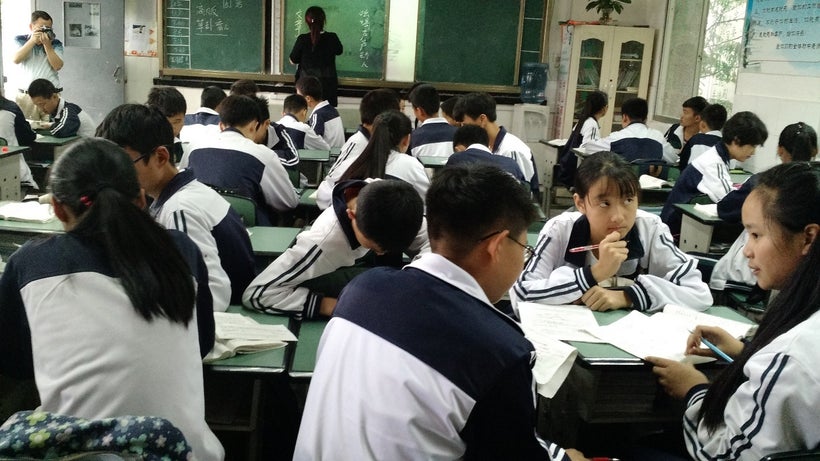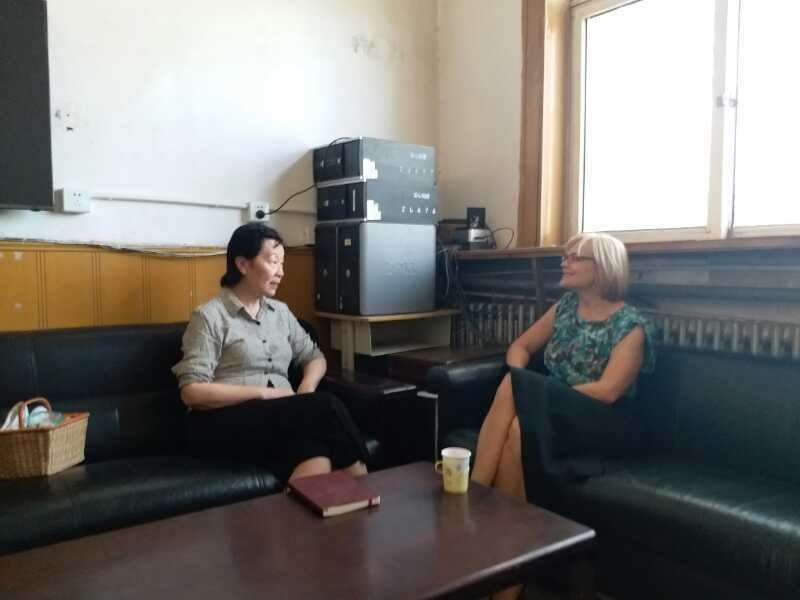If anything has the power to break boundaries, it is love.
On the evening of November 4, 2017, Adream, together with CITIC Bank Credit Card Center and Shenzhen Wei Yue Creative Investment Co., Ltd., held the “True Love Empowers the Future” – “Sharing Love” Charity Auction and Banquet in Shenzhen. Nearly 300 industry elites, celebrities, and other professionals from all over the country came together once again to raise money for the construction of new Adream Centers, and help children grow up with self-confidence, tolerance, and self-respect!

Guests lifting their bidding signs to support Adream
This is the eighth “Sharing Love” since the very first in 2009. We owe each and every banquet to the efforts of countless people, and from every banquet emerges countless touching stories.
Sharing Love is Sharing Friendship
At the banquet, four elegant figures drew a lot of attention: Liu Man, Mai Guangli, Li Qing, and Chen Xinru – Adream’s super fundraisers and chairpersons of the fund development committee. For Adream, they are icons of love and honesty, gathering people from all walks of life, including their own friends and family, to act together for love.
Together, they spent over a half year working on item collecting, guest invitations, venue decoration, event planning, and so on, just for tonight’s banquet. They personally handled all of the planning, and pored over every detail, all to make this event a success.

The Four Adream Goddesses – Li Qing, Liu Man, Mai Guangli, and Chen Xinru (From Left to Right)
“Even though it’s the night of the banquet, I still see Liu Man running everywhere, too busy to eat or drink”
“Even though it’s the night of the banquet, I haven’t seen Ms. Mai leave the stage even once.”
“Even though it’s the night of the banquet, I haven’t seen Ms. Li Qing and Ms. Xinru take a rest. They’ve been greeting and thanking people this whole time.”
They are truly Adream goddesses. Ten years of persevering on the road of charity is evidence of ten years of friendship. Their love and charm has infected everyone!
“Change starts from the building of each Adream Center, lets us walk with our heads held high, and helps us win the next ten years.” Liu Man said.
“I’ve been lucky to be walk with Adream and many people here tonight over the past ten years. I hope we can walk together for another ten years. Another twenty years!” Mai Guangli said.
“We hope to influence even more people with the achievements we have been lucky to have made so far through the practical actions of ourselves, and our friends. Your support will always be what keeps us moving forward.” Li Qing said.
“Love is priceless, but love has a cost. Only a rational mind can support a tender heart. As a member of the development committee, I want to provide excellent supervision and feedback for every one of our donors.” Chen Xinru said.
Sharing love is sharing friendship. As the goddesses said: “Together, we are amazing!”
Sharing Love is Sharing Faith
The chairperson of Adream, Ms. Pan Jiangxue, also delivered a speech during the banquet. She said: The meaning of education lies in giving people the choice and the power to change their destiny. Adream is dedicated to promoting fair, competency-based education. We hope to help every student learn well. To not only give them knowledge for tests, but also to give them a healthy mind, and a complete personality so that they can bravely face the future challenges in their lives.

Ms. Pan Jiangxue, Chairperson of Adream, at the 2017 Sharing Love Charity Auction and Banquet
Sharing love is sharing faith. As Pan Jiangxue said: Giving children choices and courage is the meaning of education. This is the value of Adream!”
Sharing Love is Sharing Trust
We have had many donors and volunteers by our side over the past ten years. We have fought together, and supported each other. With their help, a tiny dream to help students has grown into the shared mission of 840,000 donors – developing competency-based education, promoting balance in education, and promoting social progress through education!

(From Left to Right) Famous pianist and super consultant Mr. Zhao Yinyin, Chairperson of the Adream Fund Development Committee Ms. Liu Man, Chairperson of Adream Ms. Pan Jiangxue, famous actress and Adream board member Ms. Chen Shu, Vice Chairperson of the Adream Fund Development Committee Ms. Li Qing, and Northern Lights Venture Capital Investor Mr. Deng Feng at the banquet.

Thank you to all the volunteers who have supported “Sharing Love” over the years. You are giving 3,100,000 children a better tomorrow, giving them love, and a dream. The road ahead may be bumpy, but with your trust, Adream can keep moving forward. Thank you to all compassionate people for your generosity and dedication.
Sharing Love is Sharing Companionship
With auctioneer, donator, and veteran volunteer Zheng Xiaoxing as the night’s MC, the first item up for bid – “The Dream in your Heart” performed by children from the Shenzhen Vanke City Experimental School – collected continuous donations, finally reaching a historic grand total of RMB 4,200,000.

Second Generation of Adream – Zeng Tongxin singing “The Dream in your Heart”

The band formed by three children, SIX ONE, also performed the song “Glory Years”, winning unanimous praise and raising a total of RMB 2,100,000 in donations.
Zeng Ziwei, Lin Zeen, and Zhuang Qi of SIX ONE performing “Glory Years”
Compassionate donors from all walks of life donated over 50 precious paintings, sculptures, antiques, jewelry, and other such luxury goods for the night’s auction. Including the silent auction and off-site donations, total fundraising amounted to RMB 51,800,000 – a new record for “Sharing Love!” This means we can match funding for the construction of over 500 new Adream Centers, and help more than 500,000 additional children.
As Liu Man announced the night’s total, she couldn’t hold back her tears of joy. She said, “As in the lyrics for “Chinese Love and Dreams”: Chinese love and dreams have never changed – and after ten years, Adream has never changed! Thank you to every Adream partner. Your support has made this a marvelous night!”

The four Adream goddesses and lovable volunteers together on-stage to announce the night’s fundraising total
Ten years, never forgetting our goal, calling to the future; Ten years, thanking those who walked with us, creating a boundless future; Ten years, giving our all for love, empowering people to see into the future. As Albert Camus once said, “Don’t walk behind me, I may not lead. Don’t walk in front of me, I may not follow. Just walk beside me and be my friend.” True love is boundless, it empowers the future. Hope for every voice of love to be forever passed down, hope for every dream to shine brilliantly.

This year’s Sharing Love Charity Auction and Banquet raised a total of RMB 51,800,000, setting a new record.
Special Thanks
Liu Man, Founder of Adream, Director, Chairperson of the Adream Fund Development Committee, General Manager and Board Member of the China International Capital Corporation, Business Equities Department
Li Qing, Vice Chairperson of the Adream Fund Development Committee, Chairperson of Shenzhen Wei Yue Creative Investment Co., Ltd.
Mai Guangli, Vice Chairperson of the Adream Fund Development Committee, Chairperson of the Overseas Chinese Town Swan Castle Club
Chen Xinru, Vice Chairperson of the Adream Fund Development Committee, CEO of Shenzhen Yuanzheng Investment and Development Co., Ltd.
Bai Hongbiao, Famous Actor
Chen Shu, Honorary Board Member of the Adream Foundation, Adream Pioneer, Famous Actress
Chen Yongge, Famous Director
Chai Sen, President of Thunder Tiger Robot Industry Co., Ltd.
Deng Feng, Founder and General Manager of Northern Light Venture Capital, Famous Investor
Fan Deng, Sponsor of the Fan Deng Book Club, CCTV Host
Gao Xiaosong, Famous Musician
Hu Haiquan, Famous Singer
Juan Zi, MC
Li Ming, Famous Actor
Liu Jing, Vice Chairperson of the Adream Fund Development Committee
Ren Quan, Famous Celebrity
Ren Zewei, Famous Actor
Sun Weimin, Vice President of the Suning Business Group
Sun Nan, Famous Singer
Xu Qianya, Famous Singer
Xu Xia, Famous Singer, Vice Chairperson of the Shenzhen Musicians Association, Art Director for the Shenzhen Grand Theater
Xiao Peng, MC
Yang Zhongguo, President of the China Silver Land Investment Group
Yang Xiangyang, President of the Shenzhen Municipal Government Investment and Development Co., Ltd.
Yang Jianheng, Owner of Sunsing Tea
Zheng Haitao, President of Shenzhen Jiufu Investment Consultants Co., Ltd.
Zheng Shaoxing, Famous Auctioneer
Zheng Weihe, Huang Li, Shenzhen Tongchuang Wai Yip Asset Management Co., Ltd. CEO, Founding Partner
Zhao Yinyin, Famous Pianist
Zuo Jin, Famous Artist
Zhang Wei, President of Cheng Tai Information Technology Co., Ltd., President of Mana Garden, Founder of the Mana Foundation
(The above list is sorted alphabetically by last name)
Special thanks
CITIC Bank Credit Card Center Ai · Xin · Hui, China UnionPay, China International Capital Corporation Limited, Shenzhen Wei Yue Creative Investment Co., Ltd., Shenzhen Xiang Shehui Restaurant Management Co., Ltd., Yuanzheng Investment Development Co., Ltd., Jiu Fu Investment Advisory Co., Ltd. , China Silver Land Investment Co., Ltd., Thunder Tiger Robot Industry Co., Ltd., China Merchants Fund Management Co., Ltd., Tongchuang Venture Capital Co., Ltd., Northern Light Venture Capital Co., Ltd., Suning Cloud Commerce Group Co., Ltd., Yingxiang Co., Ltd., Golden Land (Group) Co., Ltd., Shenzhen Art State Art Center, Excellence Home Group Co., Ltd., Four Seasons Hotel, Shenzhen Orange Vientiane Communication Co., Ltd., Shanghai West Street Information Technology Co., , Shenzhen Times China Entertainment Media Co., Ltd., Shenzhen Shandai Tea Industry Chain Co., Ltd., Otto Packaging and Transportation Co., Ltd., Shenzhen City, Shenzhen Runzhiyuan Potable Water Technology Co., Ltd., First Road Show, Shenzhen Yuanyehua Co., Shenzhen Mingshang View Advertising Co., Ltd., Shenzhen Inspire Advertising Co., Ltd., EBEY Information Technology (Shanghai) Co., Ltd., Greater China Overseas Chinese Cultural Exchange Base






























